The NVIDIA GeForce RTX 2080 Ti & RTX 2080 Founders Edition Review: Foundations For A Ray Traced Future
by Nate Oh on September 19, 2018 5:15 PM EST- Posted in
- GPUs
- Raytrace
- GeForce
- NVIDIA
- DirectX Raytracing
- Turing
- GeForce RTX
Power, Temperature, and Noise
With a large chip, more transistors, and more frames, questions always pivot to the efficiency of the card, and how well it sits with the overall power consumption, thermal limits of the default ‘coolers’, and the local noise of the fans when at load. Users buying these cards are going to be expected to push some pixels, which will have knock on effects inside a case. For our testing, we use a case for the best real-world results in these metrics.
Power
All of our graphics cards pivot around the 83-86W level when idle, though it is noticeable that they are in sets: the 2080 is below the 1080, the 2080 Ti sits above the 1080 Ti, and the Vega 64 consumes the most.
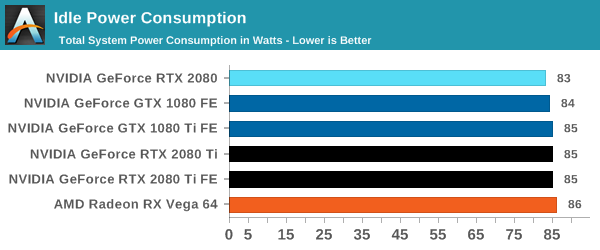
When we crank up a real-world title, all the RTX 20-series cards are pushing more power. The 2080 consumes 10W over the previous generation flagship, the 1080 Ti, and the new 2080 Ti flagship goes for another 50W system power beyond this. Still not as much as the Vega 64, however.
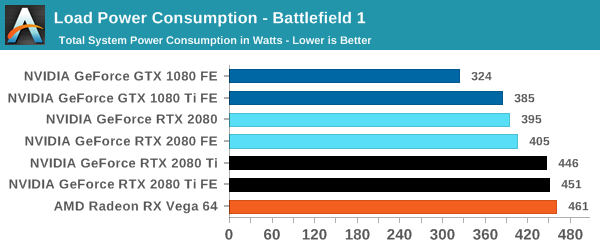
For a synthetic like Furmark, the RTX 2080 results show that it consumes less than the GTX 1080 Ti, although the GTX 1080 is some 50W less. The margin between the RTX 2080 FE and RTX 2080 Ti FE is some 40W, which is indicative of the official TDP differences. At the top end, the RTX 2080 Ti FE and RX Vega 64 are consuming equal power, however the RTX 2080 Ti FE is pushing through more work.
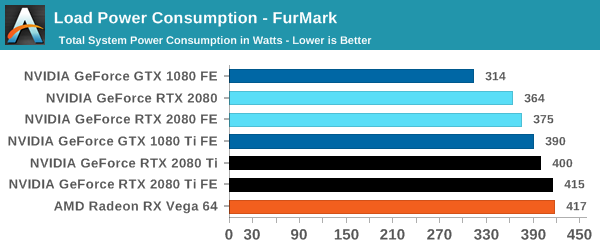
For power, the overall differences are quite clear: the RTX 2080 Ti is a step up above the RTX 2080, however the RTX 2080 shows that it is similar to the previous generation 1080/1080 Ti.
Temperature
Straight off the bat, moving from the blower cooler to the dual fan coolers, we see that the RTX 2080 holds its temperature a lot better than the previous generation GTX 1080 and GTX 1080 Ti.
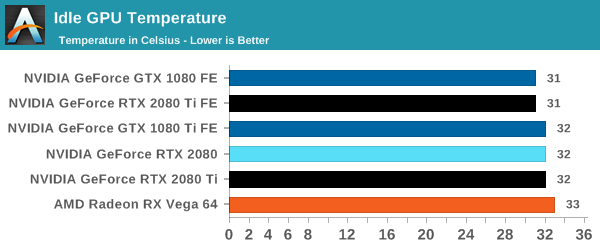
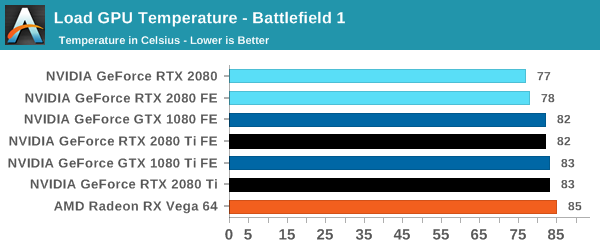
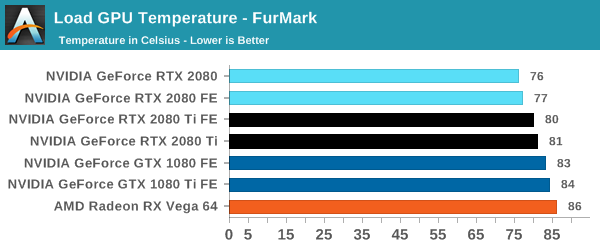
At each circumstance at load, the RTX 2080 is several degrees cooler than both the previous generation and the RTX 2080 Ti. The 2080 Ti fairs well in Furmark, coming in at a lower temperature than the 10-series, but trades blows in Battlefield. This is a win for the dual fan cooler, rather than the blower.
Noise
Similar to the temperature, the noise profile of the two larger fans rather than a single blower means that the new RTX cards can be quieter than the previous generation: the RTX 2080 wins here, showing that it can be 3-5 dB(A) lower than the 10-series and perform similar. The added power needed for the RTX 2080 Ti means that it is still competing against the GTX 1080, but it always beats the GTX 1080 Ti by comparison.
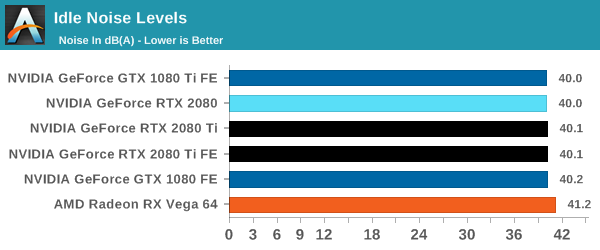
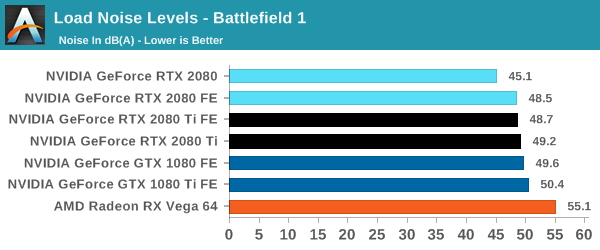
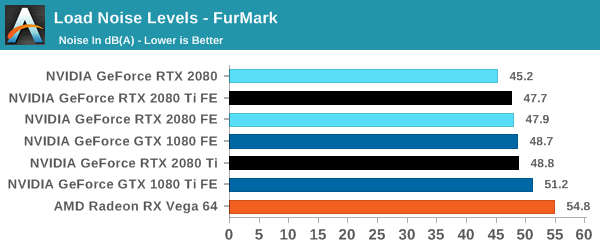










337 Comments
View All Comments
ESR323 - Wednesday, September 19, 2018 - link
I agree with the conclusion that these cards aren't a good buy for 1080ti owners. My 1080ti overclocks very nicely and I'll be happy to stick with it until the next generation in 7 nm. By then we might have a decent selection of games that make use of ray tracing and the performance increase will be more appealing.imaheadcase - Wednesday, September 19, 2018 - link
Yah i agree, especially its only a 20-25fps increase on average. While many might thing thats great, considering the price increase over 1080TI and the fact many 1080TI can overclock to close that gap even more. The features don't justify the cost.However, it could be lots of performance could be unlocked via driver updates..we really don't know how tensor cores could increase performance till the games get updated to use it. Also, while super expensive option...how does the new SLI performance increase performance? Lets see a compare from 1080TI sli to newer sli 2080TI..maybe its easier to put into games? So many what-ifs with this product.
I feel this product should of been delayed till more games/software already had feature sets available to see.
Aybi - Thursday, September 20, 2018 - link
There wont be driver&optimization support for 1000 series. They will focus on 2000 series and with that the gap going to increase a lot.If you remember 980ti and 1080ti it was the same case when 1080ti announced and then you know what happened.
Vayra - Friday, September 21, 2018 - link
Actually I don't and there is also no data to back up what you're saying. The 980ti still competes with the 1070 as it did at Pascal launch.Don't spread BS
Matthmaroo - Sunday, September 23, 2018 - link
Dude that’s not true at allNvidia will fully support the 10 series for the next 5 -10 years
They all use the same CUDA cores
Don’t just make crap up to justify your purchase
SanX - Thursday, September 20, 2018 - link
What the useless job the reviewer is doing comparing only to latest generstion cards? Add at least 980Ti and 780TiMrSpadge - Thursday, September 20, 2018 - link
Ever heard of their benchmark database?Ryan Smith - Thursday, September 20, 2018 - link
You'll be glad to hear then that we'll be backfilling cards.There was a very limited amount of time ahead of this review, and we thought it to be more important to focus on things like clocking the cards at their actual reference clocks (rather than NVIDIA's factory overclocks).
dad_at - Sunday, September 23, 2018 - link
Many thanks for that, I think it is useful job, people are still using maxwell(or even older) generation GPU in 2018. And when we could expect maxwell (980/980ti) results to appear in GPU 2018 bench? Could you also please add Geforce GTX Titan X (maxwell) to GPU 2018?StevoLincolnite - Sunday, September 23, 2018 - link
Hopefully you back-fill a substantial amount, the GPU bench this year has been a bit lacking... Especially in regards to mid-range and older parts.Whole point of it is so that you can see how the latest and greatest compare it to your old and crusty.